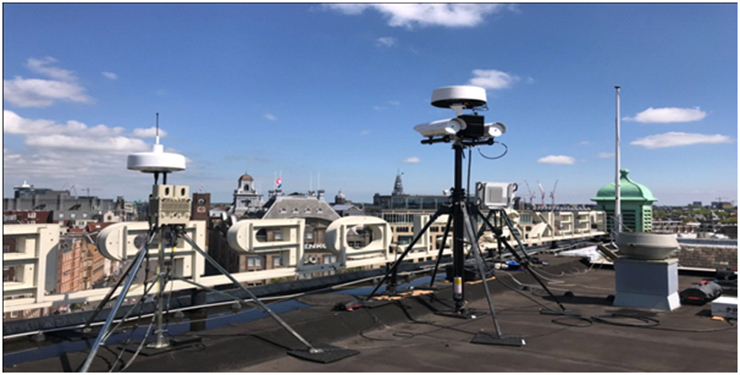Monitoring the airspace is an important task. Even more so when dangers are becoming smaller and smaller: The use and circulation of small drones has increased substantially over recent years and months. While some regulatory frameworks exist, their implementation has proven difficult in practice. Airports especially are high-risk areas, as a collision between drones and airplanes – whether intentional or not – may result in accidents and even deadly crashes. Added to that the risk of drones employed as weapons by dropping explosives, biological or chemical substances, it becomes clear that airports and other critical infrastructures must be continuously monitored, secured and have access to means of intervention in cases where drones may enter their airspace. Andleeb Shadman, Managing Director of Hensoldt Pvt. Ltd in an interesting conversation with Markus Wolf, Director Sales & Business Development of Xpeller Counter UAV Solution at Hensoldt Ventures.

AS: Could you describe global threat perceptions for which global customers buy Counter UAV Systems and what are the key criteria that influence their choice in selecting the System?
MW: Hostile UAVs are becoming one of the biggest threats is recent years. They are cheap, easy to operate, available everywhere, almost invisible and usable for a variety of attacks. Several incidents within the last few years have revealed that there is a rapidly emerging threat caused by small, cheap and commercially available drones. In 2016 alone there were 70 reported near misses at Heathrow. Recent incidents like the lethal drone attack on Saudi Arabia’s largest petroleum company and arms dropping by UAVs in Punjab, India from across the India-Pakistan border has alerted Indian security and intelligence agencies. It is estimated that India has over six lakh rogue or unregulated unmanned aerial vehicles (UAVs) and security agencies are looking for pragmatic solutions.
Whether they are used for trafficking, industrial espionage, sabotage, terrorist acts or even unintentional this phenomenon is an emerging threat that must be countered. To do so, it is key to detect and identify the drone and assess its threat potential at ranges from a few hundred meters up to several kilometres of distance from the sensitive area.
Practical Counter UAV solution (CUS) should maximize true positives and minimize false negatives. We have observed globally that key customer criteria for choosing a Counter UAV solution is influenced by local threat perceptions, i.e. type and mission of UAV, legal, regulatory or practical constraints in installing radar and/or selection of counter measures and contentment of collateral damages etc.
AS: Could you please describe Xpeller system?
MW: The Xpeller approach towards countering the UAV threat is based on a multi sensor/effector layer and a three step workflow:
- Detect the potential threat with the best possible probability of detection.
- Identify the potential threat as an actual threat with the least possible false alarm rate.
- Act on the threat by raising alarms, or engaging the threat with a counter measure.

Xpeller is highly efficient, modular and scalable counter UAV system designed for civil and military domains. The system allows combination of radar, electro-optical and RF signals, all integrated in operational software for an optimized detection of unauthorized drone threats. The resulting signal domination allows an optimized usage of countermeasures such as intercepting signals to defeat the drone threat successfully.
AS: What is the USP of HENSOLDT Solution?
MW: The Counter UAV solution market has been consistently growing with increasing in threats due to terrorism and illicit activities across the world and rising incidences of security breaches by unidentified drones.
There are been numerous players in the market acting locally and globally offering variety of solutions.
The key differentiating factors for HENSOLDT solution are:
- Mature and already in-service
- Scalable and modular solution framework catering to different needs of customers
- Man portable, Vehicle mounted and Fixed installations
- Catalogue of sensors and effectors to pick and chose
- Very high probability of intercept and very low false alarm rate
- Limited Interference with friendly use of air-space and spectrum.
- Complete solution available based on Inhouse-products with no third-party interdependency.
AS: How Mature is the solution? Are there success stories?
MW: In 2018, HENSOLDT demonstrated its Xpeller counter-UAV system at the Airbus airfield in Hamburg. During the demonstration, Xpeller detected UAVs approaching from a number of locations and was able to identify a variety of UAVs, including small recreational models, from a distance of several miles away.
Among our most recent successes is supporting the German Armed Forces in the protection of their forward operating bases in their operational areas.
The Xpeller modules are used as part of container-based drone defence systems within the GUARDION overall system of ESG Elektronik system- und Logistik-GmbH and its partners for a total of five drone defence systems. “The Spexer2000 3D radar is characterized by outstanding detection capabilities, especially against asymmetric threats. The Z:NightOwl M camera was specially developed for high ranges. With it, we support drone defence against so-called Class I drones, that is, unmanned aircraft weighing up to 25 kg.
In addition to permanent deployment, customers also use the system for temporary protection of major events. A recent example was the deployment of Xpeller during the Dutch Day of Remembrance in Amsterdam in May 2020, marking the successful introduction of Xpeller as a service.
AS: How do you see Indian market for counter drone solution? What are your plans to offer this solution to Indian customers?
MW: India is the vast country with challenging security situations. There have been several instances related to drone threats in civil and military areas.
We are also cognizant about India’s uncompromising focus on Military self-Reliance through “Make in India” policy.
Our proposed approach is to offer complete Xpeller solution framework to Indian customers. Through a Joint development we could realize an Indigenous Counter UAV solution in the most practical and incremental way, for example in supporting Indian capabilities like Sensors or 3rd Party Hard Kill effectors with selected Xpeller modules.
We offer following three variants of Xpeller for Armed forces and Critical National Infrastructure (CNI) like Airports, Govt Establishments, Power Stations, International Borders
- Xpeller Gear is a wearable and light weight configuration allowing highly mobile operations of patrol forces.
- Xpeller Rapid is a mobile system configuration that is easily transferable and rapidly deployable.
- Xpeller Guard is a fixed site system configuration that is installed for continuous operations in complex and wide surveillance
Xpeller with its inherent modularity of design, Multi-pronged Evolutionary approach involving technology and capability enhancement across the system in all components – sensors and effectors, feasibility of integration of parallel systems or add on Sensors and effectors in its architecture fits in well with this approach.








